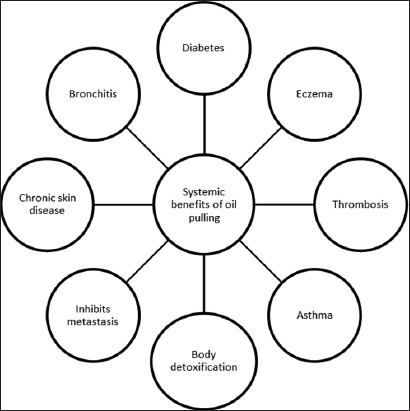Oil Pulling Can Boost Your Health
An ancient technique of Ayurveda, the process of oil swishing is believed to cure or control 30 different types of systemic diseases including headaches, migraine, and chronic diseases such as asthma and diabetes mellitus. Not to mention its exemplary benefits on our oral health. Deepa Desa delves into the details.
If you’ve been watching the recent ad with the lovely and healthy Malaika Arora extolling the benefits of oil swishing or pulling, then you are publicly aware of what most Ayurveda doctors, yoga gurus and dental care experts have been advising for decades. Oil pulling is good for you.
An Ayurvedic technique for good health
Oil pulling is an ancient Ayurvedic therapy for maintaining oral hygiene and is specified in the ayurvedic text Charak Samhita and Sushruta Samhita as ‘Kavala Graha’ or ‘Kavala Gandoosha’.
In Gandoosha the mouth is completely filled with oil such that gargling is impossible whereas in Kavala Graha comfortable lesser quantities of oil is used such that gargling is possible.
Our Oral health is the gateway to general health of our systems
We are all aware that oral health serves as a gateway to general health and well-being. In recent years, various studies have provided unequivocal evidence on the strong relationship between systemic and oral diseases, revealing common risk factors shared between various diseases and poor oral health
Periodontal diseases (such as gingivitis and periodontitis), and dental caries are the most common forms of oral diseases. The incidence of periodontal disease is found to be greatest in diabetic patients and those with heart diseases, as compared to the healthy population.
Similarly, a thorough examination of the gingival tissue can point toward a significant deficiency of Vitamin C and other nutritional deficiencies. Dental caries, which is also one of the most common forms of infectious diseases globally, has been found to significantly affect the systemic health, and quality of life of individuals.
Did you know that our oral cavity serves as a focal point of entry for pathogens into the systemic circulation?
A lack of oral hygiene allows an increase in virulent microbial colonisation of the oral tissues. An emphasis on preventing oral diseases can lead to a reduction in the incidence of various systemic diseases as well. Similarly, routine screening and oral examinations may help in identifying early manifestations of systemic diseases in the oral cavity and help in preventing disease progression.
Why should we swish or pull oil?
Oil pulling or oil swishing, as the name suggests involves vigorous swishing of oil in the oral cavity to achieve local and systemic benefits, similar to the modern day use of mouthwashes and oral rinses. It has been used for centuries for the treatment and prevention of various oral and systemic diseases, using edible oils derived from either sunflower, sesame, or coconut.
The process of oil swishing is believed to cure or control 30 different types of systemic diseases including headaches, migraine, and chronic diseases such as asthma and diabetes mellitus. The effects of oil pulling on oral health, as an adjunct to conventional oral hygiene measures have been exemplary. Scientific evidence suggests that oil pulling therapy may reduce the total oral bacterial count and reduce plaque and gingival scores.
How should you swish oil?
- Oil pulling is performed preferably in the morning on an empty stomach.
- One tablespoon (approximately 10 ml), of coconut, sesame, sunflower, or olive oil, being the recommended dose for adults is sipped, and swished between the teeth. Tip: If it’s your first time, you may want to try just a teaspoon and swirl for five minutes,to get the feel and experience of oil swishing.
- For a duration of approximately 15 min swirl the oil all around your mouth. Swishing the oil for the recommended duration in the oral cavity changes the viscosity of the oil, which turns milky white with a thin consistency.
- Swallowing the oil should be avoided as it may have toxins and bacteria, which are harmful to general health.
- Oil pulling should be followed by rinsing, conventional tooth brushing and flossing.
- The practice should preferably be performed three times daily for acute diseases.
- While there are no suggested contraindications, it is not advisable for children below the age of five years to perform oil pulling.
- If your jaw aches, then the procedure can be done just for 5–10 min.
- The oil should not be spat into the sink as the oil can cause clogging of the pipes. Instead, the oil should be spat into a trashcan or on a paper towel.
- Oil pulling is best practiced in sitting position with chin up.
How it works
While there are numerous theories, the exact technical working of oil pulling is unclear.
- One theory speculates a mechanism involving alkali hydrolysis of fat, resulting in saponification or “soap making” process. Since the oils used for oil pulling contain fat, the alkali hydrolysis process emulsifies the fat into bicarbonate ions, normally found in the saliva. Soaps which are effective cleaning agents blend in the oil, hence increasing the surface area of the oil, and in turn increasing the purifying action.
- Another theory suggests that the viscous nature of the oil inhibits plaque accumulation and adhesion of bacteria.
- The third theory hypothesises that the antioxidants present in the oil cause detoxification by preventing lipid peroxidation, resulting in an antibiotic-like effect. Thus helping in the destruction of microorganisms and promotes the action of Vitamin E in the oral cavity.
Commonly used oils for oil pulling and their action
Sesame oil
Sesame oil contains three lignans (sesamin, sesamolin, and sesaminol). These components of sesame oil possess antioxidative properties that reduce lipid peroxidation by diminishing the free radical injury to oral tissues.
Coconut oil
Coconut oil is composed of 92% saturated acids, with lauric acid making up for 50% of these saturated acids. Lauric acid can react with alkalis present in saliva such as sodium hydroxide and bicarbonates to form sodium laureate-soap like substance, which reduces plaque adhesion and accumulation, and possesses a cleansing action. Lauric acid has antimicrobial, anti-inflammatory properties, prevents dental caries and is beneficial to oral health
Olive oil
Olive oil contains 70% monounsaturated fatty acids with oleic acid as predominant constituent. It also contains plant phenolic compounds, squalene, phytosterols; vitamin A, E and K. These constituents have antimicrobial, immune modulatory and antioxidative effects. Oil pulling with olive oil is presumed to prevent oral odour or bad breath.
Almond oil added in a mouth rinse is suggested to result in low gingival scores whereas olive oil based mouth rinses are believed to inhibit plaque formation. All these oils have detoxification, antioxidant, and antibiotic actions
So should you start oil pulling if you haven’t already?
Yes. Numerous studies have been conducted recently supporting this ancient technique for its health benefits. Oil pulling is suggested for adjunct use with tooth brushing and flossing, to maintain optimum oral health care. Oil pulling as a daily health habit has significant potential to your improve health and well-being.









